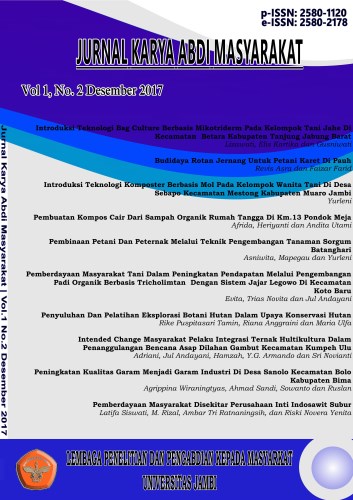INTENDED CHANGE MASYARAKAT PELAKU INTEGRASI TERNAK HULTIKULTURA DALAM PENANGGULANGAN BENCANA ASAP DI LAHAN GAMBUT KECAMATAN KUMPEH ULU
DOI:
https://doi.org/10.22437/jkam.v1i2.4291Abstract
Setiap tahun wilayah kumpeh selalu mengalami kebakaran hutan yang berdapak pada banyaknya asap yang ditimbulkan, ditambah lagi kebiasaan masyarakat dalam pengolah lahan pertanian dengan membakar dengan alasan lebih mudah, murah dan sisa pembakaran bisa menjadi pupuk. Namun sebagian besar wilayahnya terdiri atas lahan gambut yang mudah terbakar jika terjadi kemarau dan api sulit dikendalikan. Tentunya ini menjadi masalah sekaligus tantangan untuk bisa merubah pola pengolahan lahan yang selama ini dilakukan kearah yang lebih baik (Intended-Change). Survei pendahuluan, wawancara dengan masyarakat dan kelompok tani di Kumpeh Ulu bahwa kebiasaan masyarakat sudah turun temurun dilakukan yaitu membakar lahan 1-3 minggu dengan cara menunpuk tanaman semak yang sudah ditebas, kemudian ditutup tanah dibagian atasnya dan dibakar sampai semua sisa tanaman habis. Namun karena lahanya berupa gambut, maka tanah bagian atas juga merupakan bahan yang siap terbakar. Padahal selama proses pebakaran ini terjadi pencemaran udara karena tingginya kandungan asap, sulit mengendalikan api jika sudah melebar. Potensi yang sangat menunjang dalam proses pengolahan lahan yang ramah lingkungan adalah melakukan pengolahan limbah kotoran ternak dan limbah tanaman yang ada menjadi pupuk organik. Karena selama ini petani peternak tidak mengetahui pengolahan kotoran ternak menjadi pupuk bahkan kotoran ternak yang ada dibuang begitu saja disekitar kandang yang juga mengakibatkan pencemaran udara dan air. Padahal jumlah ternak yang dimiliki kedua kelompok tani (sumber rezeki dan karya tani) tergolong banyak yaitu sapi 37 ekor dan kambing 66 ekor. Potensi kotoran dari ternak ini sekitar 851 kg per hari dalam bentuk basah dari sapi dan sebanyak ± 30 kg per hari dari kambing. Tentunya ini merupakan bahan baku yang bisa dimanfaatkan selain sisa atau limbah tanaman hultikutura yang ada. Kegiatan penyluhan dilakukan di rumah ketua kelompok sumber rezeki yang diikuti sebanyak 22 onggota kelompok tani. Materi yang diberikan pada kegiatan penyuluhan ada 3 yaitu karerateristik lahan gambut, proses pembuatan pupuk organik dari kotoran ternak dan hijauan serta materi dampak asap pembakaran terhadap kesehatan. Selain penyuluhan juga ada praktek pembuatan pupuk organik sebanyak 1 ton, dengan menggunakan 600 kg kotoran kambing, 400 kg rumput yang sudah dicacah, ditambah dengan 1 liter EM4, 5 kg dedak padi dan 2,5 kg urea. Semua bahan diaduk rata dan disimpan selama 21 hari dengan cara ditutup tarpal. Hasil evaluasi kegiatan pengabdian bahwa pupuk organik yang dihasilkan memperlihatkan bentuk fifik yang baik yaitu berwarna coklat sampai kehiataman, berbauk tanah dan bertektur gembur.
Downloads
Downloads
Published
Versions
- 2017-12-15 (1)
- 2017-12-15 (1)
How to Cite
Issue
Section
License
Please find the rights and licenses in Jurnal Jurnal Karya Abdi Masyarakat (JKAM).
- License
The non-commercial use of the article will be governed by the Creative Commons Attribution license as currently displayed on Creative Commons Attribution-NonCommercial-ShareAlike 4.0 International License.
- Author’s Warranties
The author warrants that the article is original, written by stated author(s), has not been published before, contains no unlawful statements, does not infringe the rights of others, is subject to copyright that is vested exclusively in the author and free of any third party rights, and that any necessary written permissions to quote from other sources have been obtained by the author(s).
- User Rights
JKAM's spirit is to disseminate articles published are as free as possible. Under the Creative Commons license, JKAM permits users to copy, distribute, display, and perform the work for non-commercial purposes only. Users will also need to attribute authors and JKAM on distributing works in the journal.
- Rights of Authors
Authors retain the following rights:
- Copyright, and other proprietary rights relating to the article, such as patent rights,
- The right to use the substance of the article in future own works, including lectures and books,
- The right to reproduce the article for own purposes, provided the copies are not offered for sale,
- The right to self-archive the article.
- Co-Authorship
If the article was jointly prepared by other authors, the signatory of this form warrants that he/she has been authorized by all co-authors to sign this agreement on their behalf, and agrees to inform his/her co-authors of the terms of this agreement.
- Termination
This agreement can be terminated by the author or JKAM upon two months’ notice where the other party has materially breached this agreement and failed to remedy such breach within a month of being given the terminating party’s notice requesting such breach to be remedied. No breach or violation of this agreement will cause this agreement or any license granted in it to terminate automatically or affect the definition of JKAM.
- Royalties
This agreement entitles the author to no royalties or other fees. To such extent as legally permissible, the author waives his or her right to collect royalties relative to the article in respect of any use of the article by JKAM or its sublicensee.
- Miscellaneous
JKAM will publish the article (or have it published) in the journal if the article’s editorial process is successfully completed and JKAM or its sublicensee has become obligated to have the article published. JKAM may conform the article to a style of punctuation, spelling, capitalization, referencing and usage that it deems appropriate. The author acknowledges that the article may be published so that it will be publicly accessible and such access will be free of charge for the readers.









